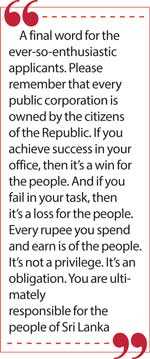Thursday Dec 12, 2024
Thursday Dec 12, 2024
Friday, 13 December 2019 00:00 - - {{hitsCtrl.values.hits}}
It is commendable that the President wants to select suitable decision-makers to public corporations without them being mere and ad hoc political appointments. However, the process thus far seems somewhat weak. Various people are complaining about the process. There had been some  embarrassing withdrawals after appointments. And there is an unacceptable lack of public communications about the progress.
embarrassing withdrawals after appointments. And there is an unacceptable lack of public communications about the progress.
So I thought of proposing a recruitment and selection process for public corporations, as a way of starting a public discussion. Before I go any further, I would like to state that I have not applied nor have the interest to hold office in any public corporation at this time. First, let’s define some of the key terms:
“Public corporation means any corporation, board or other body which was or is established by or under any written law other than the Companies Ordinance, with funds or capital wholly or partly provided by the Government by way of grant, a loan or otherwise.” (The Constitution of the DSRSL – Article 170)
“Public Institution means a department or institution of the Government, a public corporation or statutory institution.” (The Constitution of the DSRSL – Article 22)
“Official means the President, any Minister, Deputy, Minister, Governor, Chief Minister or Minister of the Board of Ministers of a Province, or any officer of a public institution; local authority or Provincial
Council.” (The Constitution of the DSRSL - Article 22)
The Sinhala term “rajya” has been translated here as “public” because it is synonymous with the “Republic”. This is another example which proves that the “public” (janathawa) is the “State” and NOT the government (aanduwa). In other words “janathawa” is the “rajaya” i.e. “janarajaya”. So the ownership of all public corporations is with the citizens of the Republic. The Government is the major shareholder. I request my Tamil colleagues to clarify if this is consistent with the Tamil version of the Constitution.
Step 1 – Organisational review
We first need to understand the current status of all the corporations before making any changes. The type of appointees at any level depends on such understanding. So as a rule of thumb, any newly elected President could run a proper holistic review focusing on the purpose, processes, the structure and finances of all public corporations.
The President may appoint a Special Committee for this purpose comprising of a few elected MPs – preferably who were not greedy enough to take up ministerial positions for three months – along with a few unelected professionals who have expertise on organisational review, audit and reporting.
Step 2 – Streamline organisational structures
Based on the findings of the above review the President could then map out the organisational structures (organograms) of all public corporations. He/she could add, remove or modify positions, chain-of-command and pay-scales while trying to streamline them across all institutions where possible for efficiency purpose. Simpler the structure, the fewer chances for corruption.
Step 3 – Design JDs
Before calling for applications, the employer, as well as the applicant, must have an understanding of the job, especially for top-level decision making positions. Every corporation is different and thus the job descriptions of all positions including the chairpersons, directors and corporate executives have to be carefully and objectively designed. And then the required qualifications, competencies, skills and experience, as well as the selection criteria, will have to be decided for each JD. The President may source the advice of corporate human resource experts in this regard.
descriptions of all positions including the chairpersons, directors and corporate executives have to be carefully and objectively designed. And then the required qualifications, competencies, skills and experience, as well as the selection criteria, will have to be decided for each JD. The President may source the advice of corporate human resource experts in this regard.
Step 4 – Advertise vacancies
Sending an application without knowing the specific job, is rather unprofessional. Only the desperate will send applications without knowing the job they want. It’s okay for internships but not for higher-level posts. So the President’s Office should advertise the vacancies with their JDs and requirements.
This will give the prospective applicants an idea of the positions they are qualified for. It will naturally check the bulk of the unqualified and incompetent people from applying. And hopefully, the too-old and business-as-usual ones who have been running public and private corporations for ages will not bother to apply at all.
The application process should be completely digital. Posting or emailing CVs is inefficient and a waste of paper. It takes too much time to download these files, open them and go through different formats to find relevant information. Data protection and privacy are also major risks. That’s why we have modern online recruitment software today which helps us to sort and compare applications based on any given criteria.
Step 5 – Shortlisting applications
The President could appoint one or more Shortlisting Boards for this purpose depending on the volume of applications. Each Shortlisting Board may comprise of a member of the cabinet of ministers, two MPs and two officials from the President’s office.
Shortlisting should be done based on previously designed scoring criteria. These criteria should be published online along with the vacancy advertisements so that the applicants will be able to provide relevant information on their application.
Step 6 – Interviewing applicants
It is a corporate best practice to have different people for shortlisting and interviewing. The shortlisted applicants must be interviewed by the Interview Boards appointed by the President under each ministry. Each Board may have the relevant minister, the secretary, two MPs nominated by the President and a minister from a different ministry. This gives the opportunity for the ministers to have a say in the process as well as the President through his nominees.
Interviewing must also be done on previously designed scoring criteria using a standard set of questions. I admit that the ministers and MPs who have not worked even at a small retail shop in their life, let alone at a corporation are not the best people to do this. So ideally they need to be trained on modern HR recruitment and selection processes (and so many more things).
Step 7 – Selection and appointment
Each Interview Board will send their top applicant and the first reserve for each position to the President. The President may choose to interview all of them or some of them as he/she thinks needed, and take the necessary steps to appoint them.
Appointing chairpersons, directors and corporate executives is not always done like this. Organisations usually headhunt for the best people to their topmost decision-making positions. So the President’s Office will have to set up a separate team for this purpose who will continuously look for talent and approach them. However, they will still have to go through the standard recruitment process.
Performance management
There will have to be a performance management software to manage these people thereafter. Setting up deliverables, success indicators, periodic reviews, training and development, etc. will have to be managed continuously and consistently across the board. It will also give the Executive President, the Executive Cabinet of Ministers, the Members of Parliament and most importantly “the public” a performance dashboard of all public corporations at a glance. This should be live and online for all citizens to see.
And a final word for the ever-so-enthusiastic applicants. Please remember that every public corporation is owned by the citizens of the Republic. If you achieve success in your office, then it’s a win for the people. And if you fail in your task, then it’s a loss for the people. Every rupee you spend and earn is of the people. It’s not a privilege. It’s an obligation. You are ultimately responsible for the people of Sri Lanka.